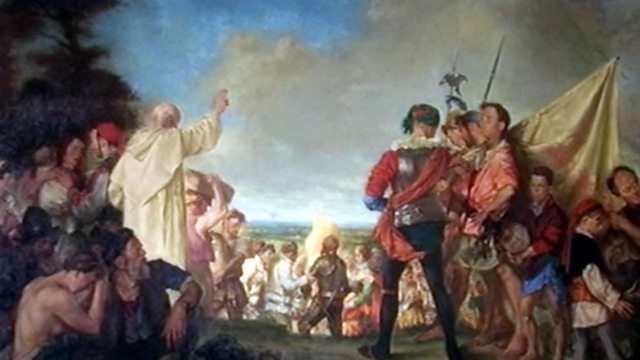The Flight of the Earls: A Tale of Exile and Legacy

In the annals of Irish history, few events resonate as profoundly as the Flight of the Earls. This pivotal moment, occurring in the early 17th century, marked the end of Gaelic Ireland’s political dominance and the dawn of a new era shaped by colonialism and upheaval. As the Gaelic lords departed their homeland for foreign shores, they left behind a legacy that continues to echo through the centuries. Let’s delve into the story of the Flight of the Earls, exploring its causes, consequences, and enduring significance.
Origins of the Flight
The Flight of the Earls, also known as the Wild Geese, refers to the mass departure of Gaelic aristocracy from Ireland in September 1607. At the time, Ireland was in the throes of political turmoil, with English rule tightening its grip on the island. The Earls of Tyrone and Tyrconnell, Hugh O’Neill and Rory O’Donnell respectively, led this exodus, accompanied by their families and retinues.
Causes of Departure
The flight was precipitated by a confluence of factors that rendered the Gaelic lords’ position in Ireland increasingly untenable. Chief among these was the culmination of the Nine Years’ War (1594-1603), a protracted conflict between Gaelic lords and English forces led by Queen Elizabeth I and later King James I. Despite initial successes, including the famous victory at the Battle of the Yellow Ford in 1598, the Gaelic forces faced dwindling resources and mounting pressure from English reinforcements.
The decisive turning point came with the Treaty of Mellifont in 1603, which effectively ended the Nine Years’ War. Although the treaty ostensibly offered terms of surrender favourable to the Gaelic lords, suspicions arose regarding English intentions to uphold these agreements. Fearing reprisals and disillusioned by the prospect of continued English rule, O’Neill, O’Donnell, and their supporters chose to depart Ireland rather than submit to English authority.
The Journey into Exile
In the autumn of 1607, the Earls embarked on their fateful journey, setting sail from Rathmullan in County Donegal. Accompanied by an entourage of followers, they boarded a ship bound for the European continent, seeking refuge in Catholic Spain or the Spanish Netherlands. Their departure marked the end of an era for Gaelic Ireland, symbolising the waning influence of indigenous Gaelic lords and the ascendancy of English colonial rule.
Consequences of Departure
The Flight of the Earls had profound ramifications for Ireland, reshaping its political landscape and irrevocably altering the course of history. In the absence of Gaelic leadership, English authorities seized the opportunity to consolidate their control over the island, implementing measures aimed at marginalising Gaelic culture and suppressing Catholicism. The subsequent plantation of Ulster, wherein English and Scottish settlers were granted land confiscated from the departing Earls and their followers, further cemented English dominance in the region.
For the exiled Earls themselves, life in foreign lands proved challenging and marked by adversity. While some sought refuge in continental Europe, others ventured as far as Rome, where they petitioned the Pope for support in their struggle against English rule. Despite occasional attempts to return to Ireland and reclaim their ancestral lands, these efforts were ultimately thwarted, consigning the Earls to lives of exile and longing for their homeland.
Enduring Legacy
Despite their departure, the Flight of the Earls left an indelible mark on Irish history and collective memory. The event has been romanticised and mythologised, symbolising the resilience of the Gaelic spirit in the face of adversity and the enduring quest for freedom and self-determination. Today, the Flight of the Earls serves as a potent symbol of Irish identity and the struggle for independence, resonating with contemporary narratives of resistance and resilience.
As Ireland commemorates the legacy of the Flight of the Earls, it honours the courage and sacrifice of those who dared to defy the forces of oppression and injustice. Their journey into exile may have marked the end of an era, but it also heralded the beginning of a new chapter in Irish history, one defined by resilience, resilience, and the unwavering pursuit of freedom.
References:
- National Archives of Ireland – [www.nationalarchives.ie]
- BBC History – [www.bbc.co.uk/history/0/21870838]
- History Ireland – [www.historyireland.com/early-modern-history-1500-1700/the-flight-of-the-earls-1607]
- Encyclopedia Britannica – [www.britannica.com/event/Flight-of-the-Earls]
- Irish History Podcast – [www.irishhistorypodcast.ie/the-flight-of-the-earls]
- The Irish Times – [www.irishtimes.com/news/the-flight-of-the-earls]
- Ireland’s History – [www.irelandshistory.ie/flight-of-the-earls]
- National Library of Ireland – [www.nli.ie]
- Discover Northern Ireland – [www.discovernorthernireland.com/flight-of-the-earls]
- Donegal County Museum – [www.donegalcoco.ie/culture/museum]
